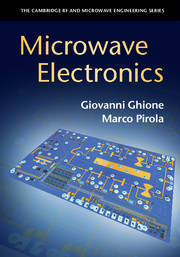Book contents
- Frontmatter
- Dedication
- Contents
- Preface
- Notation and Symbols
- 1 A System Introduction to Microwave Electronics
- 2 Passive Elements and Circuit Layout
- 3 CAD Techniques
- 4 Directional Couplers and Power Dividers
- 5 Active RF and Microwave Semiconductor Devices
- 6 Microwave Linear Amplifiers
- 7 Low-Noise Amplifier Design
- 8 Power Amplifiers
- 9 Microwave Measurements
- 10 CAD Projects
- Index
- References
6 - Microwave Linear Amplifiers
Published online by Cambridge University Press: 10 November 2017
- Frontmatter
- Dedication
- Contents
- Preface
- Notation and Symbols
- 1 A System Introduction to Microwave Electronics
- 2 Passive Elements and Circuit Layout
- 3 CAD Techniques
- 4 Directional Couplers and Power Dividers
- 5 Active RF and Microwave Semiconductor Devices
- 6 Microwave Linear Amplifiers
- 7 Low-Noise Amplifier Design
- 8 Power Amplifiers
- 9 Microwave Measurements
- 10 CAD Projects
- Index
- References
Summary
Introduction
The task of RF amplifiers is to transfer the input signal to the load with an increased power, without overly corrupting the signal through added noise and linear or nonlinear distortion (harmonic or intermodulation). From the energy standpoint, the amplifier converts DC power from the power supply into RF power to the load with a certain efficiency. The output signal should be as faithful as possible a replica of the input signal, or, in a digital context, should replicate with an acceptable error the symbols in the input signal. This requires constant gain over the frequency bandwidth and the input signal dynamic range, linear phase relationship between input and output, and, in general, low enough nonlinear distortion. Such requirements should be satisfied for the whole amplifier frequency bandwidth and for a range of the input signal amplitude defining the amplifier dynamics or Spurious Free Dynamic Range (SFDR); see Sec. 8.2.3. Because of such requirements, amplifiers should behave, within the SFDR, as linear or quasi-linear components, i.e., nonlinearity is a factor that adversely affects the amplifier performance.
As already discussed, three main amplifier classes can be found in transceivers, the Low-Noise Amplifier (LNA) whose main purpose is to amplify weak input signals to the receiver chain with an acceptable compromise between gain and noise; the highgain amplifier (present in the RX and TX stages, often in the IF section), where noise is not the main concern but the primary purpose of design is to maximize the amplifier gain; the Power Amplifier (PA), whose main purpose is to deliver an output signal of the TX chain with a power level adequate for the specific system. The PA maximum power is limited by signal distortion and, ultimately, by power saturation. The maximum power that a transistor can deliver is in fact approximately proportional to the product of the maximum output current and of the breakdown voltage, and distortion increases with increasing output power. Indeed, increasing the transistor periphery or area, thus increasing the saturation power, and keeping the output signal level low with respect to the saturation power (the so-called output backoff, see Chapter 8) is a way to reduce (in class A amplifiers) distortion, and therefore to increase the amplifier dynamics.
Information
- Type
- Chapter
- Information
- Microwave Electronics , pp. 261 - 351Publisher: Cambridge University PressPrint publication year: 2017
